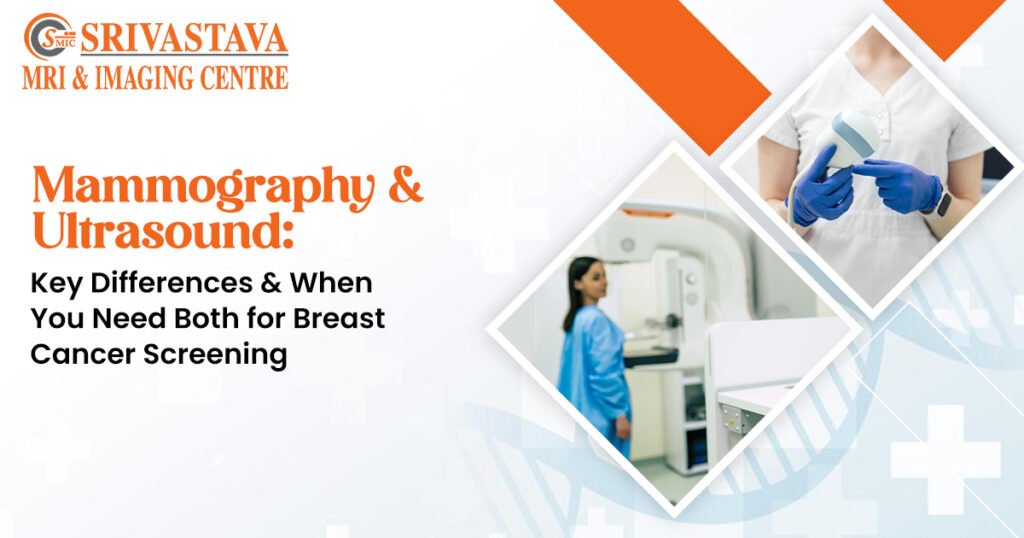A very quickly advancing disease Breast cancer is becoming common day by day. Breast cancer screening is a crucial step in early detection and treatment, allowing for better outcomes and improved survival rates. Two of the most common tools used for breast cancer screening are mammography and ultrasound. Since these techniques are often used together, they serve distinct purposes and are recommended at different stages of detection. Mammography Test Centre in Delhi
Let us explore the key differences between mammography and ultrasound, and discuss when you might need both for comprehensive breast cancer screening.
Finding the right imaging centre is essential for those suffering from breast cancer. If you are looking for a trusted Mammography Test Centre in Delhi, Srivastava MRI and Imaging Centre offers state-of-the-art services for breast cancer detection.
What is a Mammogram?
A specialized X-ray of the breast, designed to detect early signs of breast cancer, often before any physical symptoms arise is known as a mammogram. To distribute the tissue and facilitate clear image acquisition, each breast is compressed between two plates throughout the process.
What are the benefits of Mammography?
- Early detection: Mammography is particularly useful for detecting calcifications or tiny deposits of calcium in the breast, which can be an early sign of cancer.
- Screening Tool for Women Over 40: It is typically advised as an annual or biennial screening test for women 40 years of age and above.
- Detailed Imaging: Mammograms can show tumors or abnormalities that are too small to be felt
At Srivastava MRI and Imaging Centre, you can access advanced mammography services with precise imaging technology, ensuring thorough and accurate screenings.
What is an Ultrasound?
A breast ultrasound uses sound waves to create images of the internal structures of the breast. It is often used as a supplementary tool to mammography, particularly in women with dense breast tissue or when a lump is detected.
What are the benefits of Ultrasound?
Sound waves are used in a breast ultrasound to provide images of the breast’s interior anatomy. It is frequently used in addition to mammography, especially in cases when a lump is seen or in women with dense breast tissue.
- No Radiation: Ultrasounds do not involve radiation like mammograms, Therefore, making them a safer option for younger women or pregnant individuals.
- Better or Dense Breast: Women with dense breast tissue may require ultrasounds because mammograms may not capture clear images in such cases.
- Cyst vs. Solid Tumor: Ultrasound is particularly effective at distinguishing between fluid-filled cysts and solid masses, helping in further evaluation of breast abnormalities.
At Shrivastav MRI and Imaging Centre, ultrasound imaging is performed by skilled technicians and radiologists who can provide a more detailed assessment of suspicious lumps or abnormalities.
Mammogram vs. Ultrasound: Key Differences
Although mammography and ultrasonography are both crucial instruments for identifying breast cancer, their applications vary:
- Technology: Mammograms rely on X-rays to capture images, while ultrasounds use sound waves.
- Radiation: Mammography involves a small amount of radiation, whereas ultrasound does not.
- Image Clarity: Mammograms are better for detecting microcalcifications, while ultrasounds excel in evaluating masses in dense breast tissue.
- Use Cases: Mammograms are typically used as a routine screening tool, while ultrasounds are often used for further investigation after an abnormal mammogram or for women with dense breast tissue.
When Do You Need Both?
In some cases, a combination of mammography and ultrasound may be recommended to ensure a thorough evaluation:
- Dense Breast Tissue: Women with dense breasts may need both tests since mammograms might not detect certain abnormalities that ultrasound can.
- Further Investigation: If a mammogram reveals a suspicious area, an ultrasound may be needed to determine whether it is a cyst or a solid mass.
- High-Risk Patients: Women with a family history of breast cancer or those at high risk may benefit from both tests to ensure comprehensive screening.
Conclusion
Both mammography and ultrasound play critical roles in breast cancer screening. While mammograms are an excellent tool for detecting early signs of breast cancer, ultrasounds provide additional insights, especially in cases of dense breast tissue or when further investigation is required.
For individuals seeking reliable breast cancer screening, Srivastava MRI and Imaging Centre, a leading Mammography Test Centre in Delhi, offers advanced diagnostic tools to ensure accurate results. Prioritizing regular screenings and combining these imaging techniques, when necessary, can be lifesaving.
If you are due for a breast cancer screening, book your appointment at Srivastava MRI and Imaging Centre and take the proactive step in protecting your health.

